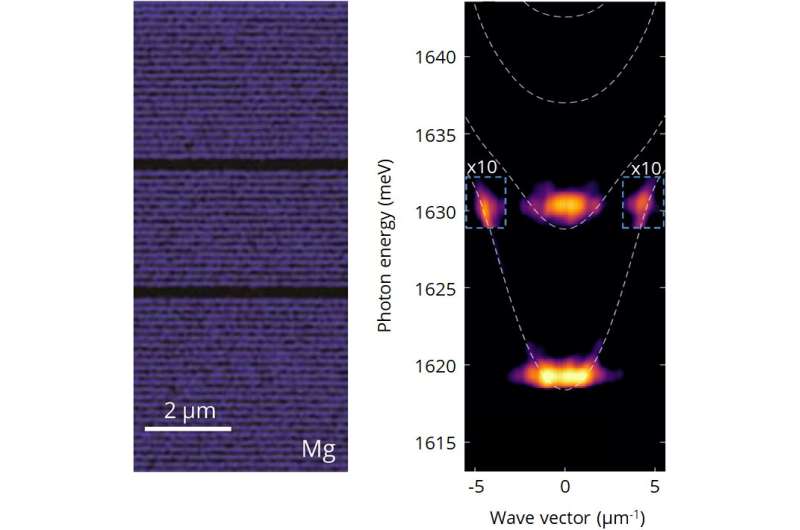Non-linear effects in coupled optical microcavities

Scientists from the Faculty of Physics of the University of Warsaw have demonstrated exciton-polariton lasing and parametric scattering of exciton-polaritons in a system of coupled optical microcavities. The results have been published in the prestigious journal Nanophotonics.
Exciton-polaritons are quasiparticles formed by a strong coupling between excitons and photons in a semiconductor. Their bosonic nature and non-linear interactions allow the observation of fascinating phenomena such as Bose-Einstein condensation of polaritons and polariton lasing, which, unlike typical lasering, occurs without occupation inversion.
Coupled microcavity systems, such as those based on two coupled optical microcavities, offer a promising multi-level platform for basic research and practical applications. The unique structure consisting of several dozen of layers with the precisely defined thickness (each with an accuracy of a few nanometers) was fabricated in the MBE laboratory at the Faculty of Physics, University of Warsaw.
“In the presented work, we study non-linear effects in a system of two coupled optical microcavities. Bose-Einstein condensation of polaritons and polariton lasing occur at the two lowest energy levels of an overall four-level system. This is a surprising result in the context of what has previously been observed in single microcavities, where condensation took place in the system’s ground state. Emission dynamics measurements have shown that in the present case the condensates of different energies share the same lasing threshold, but do not appear simultaneously, i.e. they form and disappear subsequently, one by one. Moreover, the transition to the condensate state is accompanied by an energy-degenerate parametric scattering of polaritons, i.e. the one in which the state of the crystal is preserved before and after the scattering process,” explains Krzysztof Sawicki.
In previous studies on coupled microcavities, parametric scattering was obtained using strictly resonant excitation. The non-resonant excitation used in the present work enables spectral separation of the signal from the excitation laser, which is a promising result from the point of view of implementing sources of entangled photons based on polaritons.
Previously, a coupled microcavity system was used to demonstrate energy transfer over 2 micrometers, mediated by polariton states. This is a record distance taking into account the typical nanometer scale of interaction between excitons in a semiconductor.
“We expect our results to open the way to the research on new types of non-linear effects in multi-level polariton systems. Our work is essential for such rapidly developing fields as, for example, all-optical quantum computing, since the non-linear interactions in a multi-level system may enable the implementation of logic systems based on polaritons,” adds Jan Suffczynski.
Enhanced interactions through strong light-matter coupling
Krzysztof Sawicki et al, Polariton lasing and energy-degenerate parametric scattering in non-resonantly driven coupled planar microcavities, Nanophotonics (2021). DOI: 10.1515/nanoph-2021-0079
Citation:
Non-linear effects in coupled optical microcavities (2021, July 28)
retrieved 28 July 2021
from https://phys.org/news/2021-07-non-linear-effects-coupled-optical-microcavities.html
This document is subject to copyright. Apart from any fair dealing for the purpose of private study or research, no
part may be reproduced without the written permission. The content is provided for information purposes only.
For all the latest Science News Click Here
For the latest news and updates, follow us on Google News.

